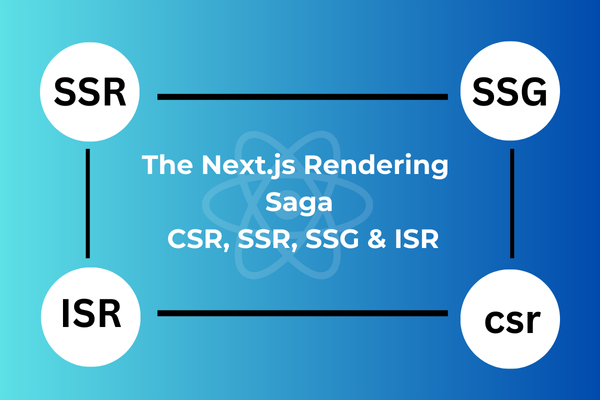Imagine you’re building the next big web app. You want blazing fast performance, SEO-friendly pages, and a great user experience. But there’s a catch: how should your pages be rendered? Should your content be pre-built, fetched on every request, or something in between?
This is where Next.js rendering strategies come in: CSR, SSR, SSG, and ISR. Understanding them is like having a map to navigate the jungle of modern web performance. Let me take you on a journey to discover which strategy fits your needs.
1️⃣ Client-Side Rendering (CSR) – The Interactive Adventure
What it is: CSR is when your browser fetches a minimal HTML shell, then runs JavaScript to dynamically load content. Think React apps you build with create-react-app.
Story analogy: Imagine opening a book whose pages are blank at first, and the story magically appears as you turn each page. That’s CSR the content comes alive after the client (browser) asks for it.
When to use CSR:
- Dashboard apps (like analytics or admin panels)
- Highly interactive UIs where SEO isn’t a priority
- Real-time updates (live chat, stock tickers, etc.)
Pros: ✅ Fast initial dev ✅ Great interactivity ✅ Less load on server
Cons: ❌ Poor SEO out of the box ❌ Slower initial content load
2️⃣ Server-Side Rendering (SSR) – The Freshly Baked Story
What it is: SSR renders your page on the server at each request and sends fully populated HTML to the client.
Story analogy: Imagine going to a bakery. You order a fresh cake, and it’s baked just for you. Every visitor gets a freshly baked page.
When to use SSR:
- Content that changes frequently (news, dashboards, user profiles)
- Pages where SEO matters
- Personalized experiences (user-specific data)
Pros: ✅ SEO-friendly ✅ Fresh content per request ✅ Works well with dynamic data
Cons: ❌ Higher server load ❌ Slightly slower TTFB (time to first byte) than pre-rendered pages
3️⃣ Static Site Generation (SSG) – The Pre-Baked Classic
What it is: SSG generates HTML at build time. The pages are ready and served as static files.
Story analogy: Think of a bakery preparing dozens of cupcakes the night before the morning rush. Everyone gets the same, perfect cupcake instantly.
When to use SSG:
- Marketing pages, blogs, documentation
- Product pages with rarely changing content
- Landing pages and portfolio sites
Pros: ✅ Lightning-fast delivery (served from CDN) ✅ SEO-friendly ✅ Low server load
Cons: ❌ Not ideal for frequently changing data ❌ Requires rebuilds for new content
4️⃣ Incremental Static Regeneration (ISR) – The Best of Both Worlds
What it is: ISR is Next.js magic: you pre-render pages like SSG, but Next.js can update them in the background after a certain interval (revalidate).
Story analogy: It’s like pre-baking your cupcakes but letting the bakery refresh a few in the background when they go stale, so every customer gets fresh content without waiting.
When to use ISR:
- Blogs with frequent updates
- E-commerce product pages
- Any page that benefits from both speed and dynamic updates
Pros: ✅ Fast as static pages ✅ Fresh content without full rebuild ✅ SEO-friendly
Cons: ❌ Slight complexity in setup ❌ Not real-time for every request
🔗 How to Decide Which Rendering Strategy to Use
| Strategy | Best For | SEO | Freshness | Server Load |
|---|---|---|---|---|
| CSR | Interactive dashboards, real-time apps | Poor | High (client-driven) | Low |
| SSR | Personalized pages, dynamic content | Good | Very high | High |
| SSG | Marketing pages, blogs, docs | Excellent | Low (build-time) | Very low |
| ISR | Blogs, e-commerce, mix of static & dynamic | Excellent | High | Low to Medium |
TL;DR:
- If you want speed & SEO → SSG or ISR
- If you want personalization & fresh data → SSR
- If you want interactivity → CSR
🎯 Wrapping Up the Story
Next.js doesn’t force you to pick just one. You can mix strategies on the same site:
- Blog: ISR for speed + updates
- Dashboard: CSR for real-time interactivity
- Landing page: SSG for blazing-fast SEO
Understanding these strategies helps you design smarter apps, impress clients, and keep your users happy.
💡 LinkedIn-Friendly Takeaways
“Are you still debating how to render your Next.js pages? Knowing when to use CSR, SSR, SSG, or ISR can be the difference between a fast, SEO-friendly site and a slow, clunky one. Read my latest blog to see how top developers make the right choice.”
“Next.js gives you the power to mix rendering strategies. Imagine serving static landing pages, dynamic dashboards, and AI-driven content all in the same app.



